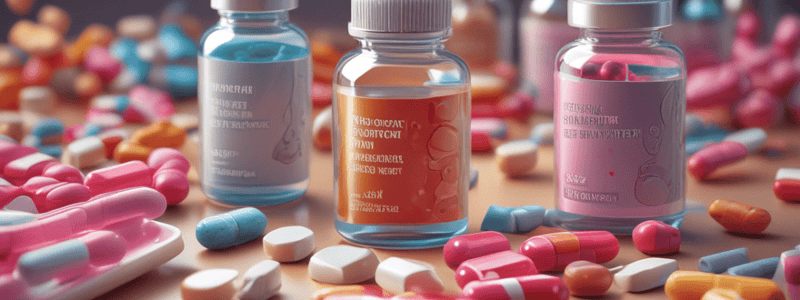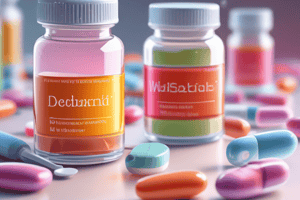Podcast
Questions and Answers
What are the two main uses of vancomycin?
What are the two main uses of vancomycin?
- Treat severe gram-positive infections due to organisms resistant to other antibiotics, such as methicillin-resistant staphylococci and ampicillin-resistant enterococci. 2) Treat infections caused by other sensitive gram-positive organisms in patients allergic to penicillins.
What is the mechanism of action of vancomycin?
What is the mechanism of action of vancomycin?
Vancomycin is bactericidal and exhibits time-dependent or concentration-independent bacterial killing, meaning it kills bacteria most effectively when drug concentrations are 3-5 times the minimum inhibitory concentration (MIC) for the bacteria.
How is vancomycin administered and how are peak concentrations measured?
How is vancomycin administered and how are peak concentrations measured?
Vancomycin is administered as a short-term (1-1.5 hour) intravenous infusion. A peak vancomycin concentration is obtained after 1.5 hours, after allowing a 0.5-1 hour waiting period for distribution to finish before measuring the peak.
Why is a waiting period allowed before measuring peak vancomycin concentrations?
Why is a waiting period allowed before measuring peak vancomycin concentrations?
What is the significance of vancomycin's time-dependent bacterial killing?
What is the significance of vancomycin's time-dependent bacterial killing?
What are the two main gram-positive organisms that vancomycin is used to treat?
What are the two main gram-positive organisms that vancomycin is used to treat?
Why is vancomycin used to treat gram-positive infections in patients allergic to penicillins?
Why is vancomycin used to treat gram-positive infections in patients allergic to penicillins?
What is the significance of vancomycin's bactericidal activity?
What is the significance of vancomycin's bactericidal activity?
What is the recommended infusion time for vancomycin to avoid side effects like urticarial reactions, flushing, and hypotension?
What is the recommended infusion time for vancomycin to avoid side effects like urticarial reactions, flushing, and hypotension?
What is the primary route of elimination for vancomycin?
What is the primary route of elimination for vancomycin?
What is the therapeutic range for steady-state peak vancomycin concentrations?
What is the therapeutic range for steady-state peak vancomycin concentrations?
Why should clinicians consider measuring peak concentrations when large doses of vancomycin are given?
Why should clinicians consider measuring peak concentrations when large doses of vancomycin are given?
What vancomycin concentrations may be necessary for central nervous system infections?
What vancomycin concentrations may be necessary for central nervous system infections?
What is the recommended trough and peak concentration range for vancomycin when high concentrations are needed for therapeutic reasons?
What is the recommended trough and peak concentration range for vancomycin when high concentrations are needed for therapeutic reasons?
What can happen if appropriate changes in vancomycin dosing are not made for ototoxicity?
What can happen if appropriate changes in vancomycin dosing are not made for ototoxicity?
Why is intramuscular administration of vancomycin usually avoided?
Why is intramuscular administration of vancomycin usually avoided?
Which vancomycin concentrations are usually related to therapeutic outcome?
Which vancomycin concentrations are usually related to therapeutic outcome?
Why are trough concentrations important for vancomycin?
Why are trough concentrations important for vancomycin?
What are some of the allergic symptoms that vancomycin can cause?
What are some of the allergic symptoms that vancomycin can cause?
What is the relationship between high trough concentrations of vancomycin and nephrotoxicity?
What is the relationship between high trough concentrations of vancomycin and nephrotoxicity?
What vancomycin concentrations relative to the organism's MIC are optimal for bactericidal effects?
What vancomycin concentrations relative to the organism's MIC are optimal for bactericidal effects?
What is the oral bioavailability of vancomycin?
What is the oral bioavailability of vancomycin?
What side effect is associated with vancomycin serum concentrations exceeding 80 μg/mL?
What side effect is associated with vancomycin serum concentrations exceeding 80 μg/mL?
Why is it important to assess renal function and auditory/vestibular function on a daily basis when high vancomycin concentrations are needed for therapeutic reasons?
Why is it important to assess renal function and auditory/vestibular function on a daily basis when high vancomycin concentrations are needed for therapeutic reasons?
What are the typical minimum pre-dose or trough steady-state concentrations of vancomycin considered adequate to resolve infections with susceptible Staphylococcus aureus and Staphylococcus epidermidis organisms?
What are the typical minimum pre-dose or trough steady-state concentrations of vancomycin considered adequate to resolve infections with susceptible Staphylococcus aureus and Staphylococcus epidermidis organisms?
Why has the therapeutic trough concentration range for vancomycin been expanded to 15-20 μg/mL in some institutions?
Why has the therapeutic trough concentration range for vancomycin been expanded to 15-20 μg/mL in some institutions?
How does the penetration of vancomycin into lung tissue compare to its serum concentration?
How does the penetration of vancomycin into lung tissue compare to its serum concentration?
What is the recommended steady-state trough concentration range for vancomycin in the treatment of hospital-acquired pneumonia, according to recent treatment guidelines?
What is the recommended steady-state trough concentration range for vancomycin in the treatment of hospital-acquired pneumonia, according to recent treatment guidelines?
What potential adverse effect is associated with vancomycin trough steady-state concentrations above 15 μg/mL?
What potential adverse effect is associated with vancomycin trough steady-state concentrations above 15 μg/mL?
Before attributing renal dysfunction to vancomycin-induced nephrotoxicity, what other potential causes should be ruled out in critically ill patients receiving vancomycin?
Before attributing renal dysfunction to vancomycin-induced nephrotoxicity, what other potential causes should be ruled out in critically ill patients receiving vancomycin?
Compared to aminoglycoside antibiotics, how does the nephrotoxicity potential of vancomycin generally compare?
Compared to aminoglycoside antibiotics, how does the nephrotoxicity potential of vancomycin generally compare?
Is vancomycin-related nephrotoxicity typically reversible or irreversible, and what factors influence the potential for residual damage?
Is vancomycin-related nephrotoxicity typically reversible or irreversible, and what factors influence the potential for residual damage?
What is the primary clinical indication that antibiotic therapy is effective?
What is the primary clinical indication that antibiotic therapy is effective?
When should vancomycin steady-state serum concentrations be measured relative to the dosing schedule?
When should vancomycin steady-state serum concentrations be measured relative to the dosing schedule?
What is the rationale for only measuring the trough vancomycin concentration?
What is the rationale for only measuring the trough vancomycin concentration?
What clinical resources should be consulted when prescribing antibiotics?
What clinical resources should be consulted when prescribing antibiotics?
What is the expected magnitude of transient serum creatinine increases due to vancomycin nephrotoxicity with adequate monitoring?
What is the expected magnitude of transient serum creatinine increases due to vancomycin nephrotoxicity with adequate monitoring?
Describe the process of monitoring a patient's clinical response to antibiotic therapy over time.
Describe the process of monitoring a patient's clinical response to antibiotic therapy over time.
Why is it important to regularly consult antibiograms when prescribing antibiotics?
Why is it important to regularly consult antibiograms when prescribing antibiotics?
What pharmacokinetic principle governs the rationale for measuring trough rather than peak vancomycin levels?
What pharmacokinetic principle governs the rationale for measuring trough rather than peak vancomycin levels?
Flashcards are hidden until you start studying
Study Notes
Vancomycin Administration and Side Effects
- Infusion rate-related side effects can occur when infusion times are shorter (~30 minutes or less), including urticarial or erythematous reactions, intense flushing, tachycardia, and hypotension.
- These side effects can be largely avoided with longer infusion times.
Ototoxicity and Serum Concentrations
- Ototoxicity has been reported when vancomycin serum concentrations exceed 80 μg/mL.
- The therapeutic range for steady-state peak concentrations is usually considered to be 20–40 μg/mL.
- Steady-state peak concentrations of 40–60 μg/mL or direct administration into the cerebral spinal fluid may be necessary for certain infections.
- Ototoxicity can be permanent if appropriate changes in vancomycin dosing are not made.
Therapeutic and Toxic Concentrations
- Vancomycin is administered as a short-term (1-1.5 hour) intravenous infusion, with a distribution phase that requires a 1/2–1 hour waiting period before measuring peak concentrations.
- Peak vancomycin concentrations are obtained after 1.5 hours.
- Minimum pre-dose or trough steady-state concentrations of 10–15 μg/mL are usually adequate to resolve infections with susceptible organisms.
- Higher trough concentrations (15–20 μg/mL) may be necessary in institutions with antibiograms that include MRSA with higher MIC values.
Nephrotoxicity and Clinical Monitoring
- Trough vancomycin steady-state concentrations above 15 μg/mL are related to an increased incidence of nephrotoxicity.
- Vancomycin-related nephrotoxicity is usually reversible with a low incidence of residual damage if the antibiotic is withdrawn or doses are appropriately adjusted soon after renal function tests change.
- Clinical monitoring parameters include antibiotic therapy prescription based on current microbiologic cultures and sensitivities, antibiograms, and patient response to treatment.
- Vancomycin steady-state serum concentrations should be measured in 3–5 estimated half-lives, and favorable response to antibiotic treatment is usually indicated by decreasing white blood cell counts, normalized body temperature, and resolution of infection site tests or procedures.
Studying That Suits You
Use AI to generate personalized quizzes and flashcards to suit your learning preferences.




